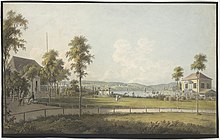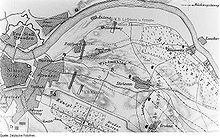Castle Anton

The castle of Anton (also "Anton's garden") was a property in the Dresden Johannstadt opposite the forest castle .
history
The tax council and chief inspector of the Elster rafting company in the Ore Mountains, Christian Gottlob Anton, had a castle-like retirement home built according to plans by the architect Simon Gottlieb Zug on the site of a former lime kiln . Since this building, with its rooms, some of which were decorated with stucco and paneling, caused considerable costs, Anton applied for the licensing rights and set up a restaurant with overnight accommodation. The bathing establishment, which he had also planned, was not approved for reasons of morality and because of a possible danger to shipping.

In 1801 the property became the property of the Broizem Secret War Council . In addition to the traditional name "Antons", it was now also referred to as Lerchenfeld. Napoleonic soldiers occupied the Vorwerk in 1813 and fights with Russian troops took place in the immediate vicinity. After these events, the castle passed into the hands of a Mr. von Limburger in 1814, who had it rebuilt in 1828 and sold it to the Kaskel banking family in 1832 . The gardens have now been redesigned according to the English pattern and the building was given a clock tower.
In 1898, after various changes of ownership, the city of Dresden bought the “Antons”, which had developed into a popular excursion restaurant and had received literary recognition from E. T. A. Hoffmann in his work The Golden Pot . The cost was 300,000 marks. Although the building was initially thought of being demolished, the establishment was still operated and a swimming pool was added in 1922, as the original owner had planned. A tunnel led from the changing rooms in the park to the banks of the Elbe. The "Antons" developed into one of the most popular outdoor pools in the city. Up to 60,000 visitors a year were counted, and the head bath attendant of all Dresden city baths had his office here. However, bathing was restricted for reasons of hygiene as early as the 1930s.
Anton's castle was destroyed by bombs in World War II. The last remains were removed in the post-war period. The area was initially used as an allotment garden, which was called "Elbfrieden II". It was to be replaced by an international campsite in the 1970s. However, these plans could never be implemented because the area was repeatedly hit by floods. After the Elbe floods in 2002 , usage plans were finally abandoned. Some old trees are still reminiscent of Anton's castle and its parks.
Web links
- History. dresdner-stadtteile.de
- "Antons" johannstadtarchiv.de
- Pictures of “Schlößchen Antons” in the Deutsche Fotothek
- Images of "Anton's garden" in the Deutsche Fotothek (not to be confused with Prince Anton's garden )
Individual evidence
- ^ Johannstadt district . Dresden-Reisefuehrer.de
- ↑ The golden pot . In: Fantasy pieces in Callot's manner . Second part. 2nd Edition. Kunz, Bamberg 1819, pp. 79–228 ( Wikisource )
Coordinates: 51 ° 3 ′ 43.2 " N , 13 ° 46 ′ 15.6" E